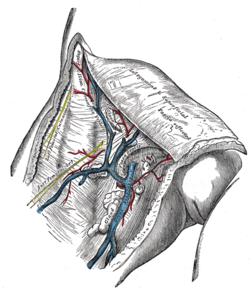- Fascia cribrosa
-
Fascia cribrosa 
The great saphenous vein and its tributaries at the fossa ovalis. Latin fascia cribrosa Gray's subject #128 468 The portion of fascia covering the fossa ovalis in the thigh is perforated by the great saphenous vein and by numerous blood and lymphatic vessels, hence it has been termed the fascia cribrosa (Hesselbach's or cribriform fascia), the openings for these vessels having been likened to the holes in a sieve.
Clinical significance
It has been proposed for use in preventing new vascularization when surgery is performed at the joint between the great saphenous vein and the femoral vein.[1]
Eponym
When the eponym is used, it is named for Franz Kaspar Hesselbach.[2][3]
References
- ^ De Maeseneer MG, Philipsen TE, Vandenbroeck CP, et al. (2007). "Closure of the cribriform fascia: an efficient anatomical barrier against postoperative neovascularisation at the saphenofemoral junction? A prospective study". Eur J Vasc Endovasc Surg 34 (3): 361–6. doi:10.1016/j.ejvs.2007.03.020. PMID 17513142. http://linkinghub.elsevier.com/retrieve/pii/S1078-5884(07)00259-6.
- ^ synd/3213 at Who Named It?
- ^ F. K. Hesselbach. Anatomisch-chirurgische Abhandlung über den Urspurng der Leistenbrüche. Würzburg, Baumgärtner, 1806.
This article was originally based on an entry from a public domain edition of Gray's Anatomy. As such, some of the information contained within it may be outdated.
List of muscles of lower limbs (TA A04.7, GA 4.465) ILIAC Region
/ ILIOPSOASBUTTOCKS THIGH /
compartmentsLEG/
Crus/
compartmentssuperficial · triceps surae (gastrocnemius, soleus, accessory soleus, Achilles tendon) · plantaris
deep · tarsal tunnel (flexor hallucis longus, flexor digitorum longus, tibialis posterior) · popliteusfibularis muscles (longus, brevis)FOOT DorsalPlantar1st layer (abductor hallucis, flexor digitorum brevis, abductor digiti minimi) · 2nd layer (quadratus plantae, lumbrical muscle) · 3rd layer (flexor hallucis brevis, adductor hallucis, flexor digiti minimi brevis) · 4th layer (dorsal interossei, plantar interossei)
This anatomy article is a stub. You can help Wikipedia by expanding it.
